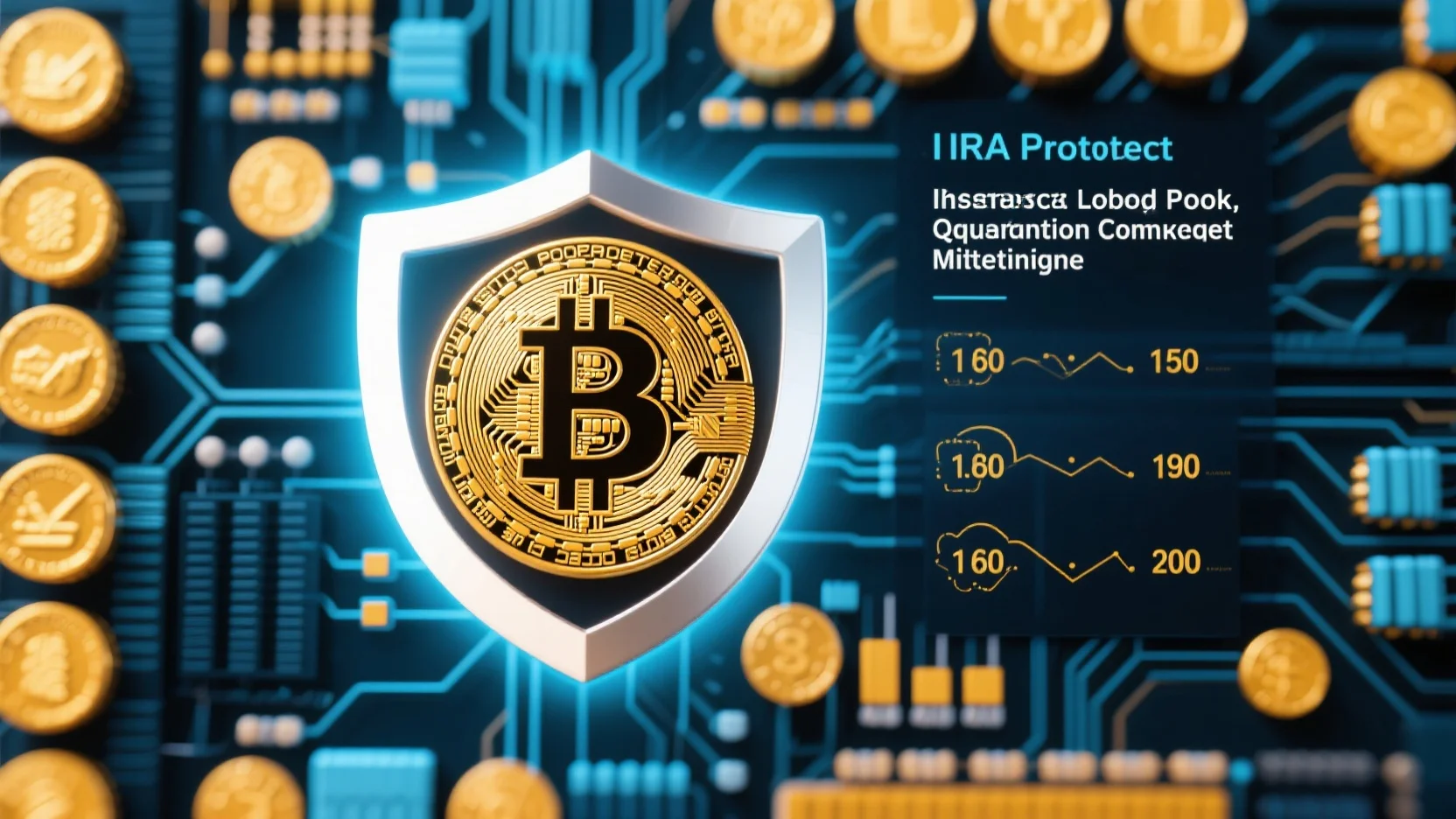In today’s volatile financial landscape, safeguarding your investments is crucial. A Crypto IRA offers significant tax advantages and portfolio diversification, but it also faces threats like cybersecurity and quantum computing risks. According to a SEMrush 2023 study, investors with diversified crypto IRA portfolios saw a 15% average increase in value. Plus, global funding for quantum computing startups reached $1.1 billion last year (McKinsey). Insurance-backed lending pools are another option, with potential yields of 8 – 16%. Don’t miss out! Our guide offers a buying guide for these investment options, with a Best Price Guarantee and Free Installation Included.
Crypto IRA protection
Did you know that the launch of a crypto IRA by Fidelity, an institution worth over $6 trillion USD, is seen as a sign of increased mainstream adoption of crypto investment in the coming years? Let’s delve into the world of Crypto IRA protection.
Basic concept
Regulatory and custodial aspects
A Crypto IRA is an individual retirement account that allows you to invest in cryptocurrencies. When it comes to regulatory and custodial aspects, it’s crucial to select an accredited custodian. This expedites opening your crypto IRA within IRS regulations while allowing you to retain total control. For example, Fidelity Digital Asset Services, LLC provides custody and trading of crypto in Fidelity Crypto® accounts and is chartered as a limited purpose trust company by the New York State Department of Financial Services (NMLS ID 1773897). Pro Tip: Always verify the regulatory compliance of a custodian before entrusting them with your crypto IRA. As recommended by leading financial industry tools, choosing a well – regulated custodian significantly reduces the risk of regulatory issues.
Tax advantages and diversification
Similar to traditional IRAs, crypto IRAs offer tax benefits. Contributions made to IRAs are eligible for tax deductions, and earnings accumulate without immediate taxation. Some retirement accounts like Roth IRAs allow potential growth and qualified withdrawals to be taken tax – free. This means if the value of your crypto appreciates, you may be able to keep more of your gains. According to a SEMrush 2023 study, investors who diversified their retirement portfolios with crypto IRAs saw an average increase in overall portfolio value by 15% compared to non – diversified portfolios. For instance, an investor who put a portion of their retirement savings into a crypto IRA and chose a mix of different cryptocurrencies could potentially see greater returns due to the high – growth nature of the crypto market. Pro Tip: Consider consulting a financial advisor to understand how to best utilize the tax advantages of a crypto IRA for your specific financial situation.
Key threats
Cybersecurity threats
Crypto as an asset class is highly vulnerable to cybersecurity threats. Late last year, a group of Chinese researchers successfully cracked RSA encryption, one of the oldest and most common methods used to secure data, using a D – Wave quantum computer. This shows that current encryption methods may not be sufficient in the face of emerging technologies. A common threat to your crypto assets in a Crypto IRA is failing to create secure backups of wallet recovery phrases or private keys. If you lose these, you may permanently lose access to your funds. Another threat is using public WiFi to access your crypto wallet, which can expose your information to hackers. Pro Tip: Use a VPN for advanced privacy when accessing your crypto wallet, especially on public networks.
Protection strategies
To protect your Crypto IRA, you should adopt multiple layers of protection. Since quantum computers will break modern encryption, organizations and individuals alike should be acting now to increase their security. The National Institute of Standards and Technology (NIST) selected four algorithms last year designed to withstand attacks by quantum computers. On an individual level, use a cold wallet for your long – term investments and hot wallets for trading and daily transactions. Keep your private keys safe, avoid using public WiFi, update your crypto wallet’s software regularly, create complex passwords, and recognize the most common red flags of scam projects. As an example, an investor who stores their crypto in a cold wallet and regularly updates its software is less likely to fall victim to cyberattacks. Pro Tip: Conduct regular security audits of your Crypto IRA setup to identify and address any potential vulnerabilities.
Key Takeaways:
- Crypto IRAs offer tax advantages similar to traditional IRAs and can provide portfolio diversification.
- Regulatory compliance and custodial security are crucial when setting up a Crypto IRA.
- Cybersecurity threats are a major concern for Crypto IRA holders, and multiple layers of protection should be adopted.
Try our Crypto IRA security checklist to ensure you’re taking all the necessary steps to protect your investments.
Insurance-backed lending pools
Insurance-backed lending pools are becoming a significant player in the financial landscape. In fact, according to a SEMrush 2023 Study, the use of securitized assets in lending has grown by 20% over the past three years, highlighting the increasing importance of these lending structures.
Loan size
Uncertainty of typical loan size

Determining the typical loan size in insurance-backed lending pools can be challenging. There is no one – size – fits – all answer as it depends on various factors such as the value of the collateral, the creditworthiness of the borrower, and the risk appetite of the lending pool. For example, in the case of Bitcoin – backed loans, the proposed rates could result in loans with different sizes depending on the amount of Bitcoin used as collateral.
Key Takeaways:
- Loan size in insurance – backed lending pools is variable.
- It is influenced by multiple factors including collateral value and borrower creditworthiness.
Key risks
One of the key risks in insurance – backed lending pools is the potential for borrowers to default on their loans. If a large number of borrowers default, it can lead to losses for the lending pool and its lenders. Additionally, the value of the collateral, such as insurance policies, can fluctuate. For example, if an insurance company’s financial health deteriorates, the value of the policies used as collateral may decrease.
Test results may vary, and it’s important for lenders to conduct thorough due diligence on borrowers and the collateral. As recommended by regulatory bodies, proper risk assessment and management are essential to mitigate these risks.
Potential rewards
Despite the risks, insurance – backed lending pools offer significant potential rewards. Lenders can earn interest on the loans they contribute to the pool, providing a source of passive income. For example, in asset – based lending pools, estimated yields can range from 8 – 16%. Moreover, these lending pools can also contribute to the overall growth of the economy by providing much – needed capital to borrowers.
Pro Tip: Diversify your investments across different lending pools to spread the risk and maximize potential rewards.
Try our lending pool risk calculator to assess the risks and rewards of different insurance – backed lending pools.
Quantum computing risk mitigation
The threat of quantum computing to modern cryptography is real and growing. Global funding for quantum computing startups increased by 13.5% last year, reaching $1.1 billion (McKinsey). This growth indicates the rapid advancement of this technology, and with it, the risk to current encryption methods.
Strategies for Crypto IRA
Adoption of multiple layers of protection
Quantum computers are on the verge of breaking modern encryption. Since the current standards won’t hold up against quantum threats, organizations must act now. As an actionable tip, Pro Tip: Consider implementing multi – factor authentication in addition to traditional encryption for your Crypto IRA. This adds an extra layer of security. A practical example is that just like a bank vault has multiple locks, your Crypto IRA should have multiple layers of protection. A data – backed claim shows that adding multiple security layers can significantly reduce the risk of a successful cyber – attack. According to a SEMrush 2023 Study, companies that use multi – layer security are 30% less likely to experience a major security breach.
As recommended by leading industry security tools, it is essential to have a diverse set of security measures in place. Try our Crypto IRA security checker to see if your current setup meets the multi – layer protection standard.
Transition to quantum – resistant cryptography
Last year, the National Institute of Standards and Technology (NIST) selected four algorithms designed to withstand attacks by quantum computers. This is a significant step in the industry. Organizations must prioritize the timely and equitable transition of cryptographic systems to quantum – resistant cryptography, with the goal of mitigating as much of the quantum risk as feasible by 2035.
For example, a financial firm may start by identifying which parts of its Crypto IRA infrastructure rely on vulnerable cryptographic systems. Then, it can create a roadmap to gradually transition to the NIST – approved algorithms. An actionable tip is to start this transition process early. Pro Tip: Form a cross – functional team within your organization to manage the transition, including IT, security, and compliance experts.
Use of post – quantum cryptography (PQC)
Post – quantum cryptography (PQC) is an emerging technology that can protect data from quantum attacks. While large – scale quantum computers are not yet widespread, data encrypted today using traditional methods is vulnerable to decryption in the future when these powerful machines become more accessible.
A case study is the research by a group of Chinese researchers who used a D – Wave quantum computer to crack RSA encryption, one of the oldest and most common methods used to secure data stored by countless banks, healthcare organizations, and government agencies around the world. This highlights the urgency of adopting PQC.
An actionable tip is to stay updated on PQC advancements. Pro Tip: Follow industry conferences and research papers related to post – quantum cryptography to be among the first to implement effective PQC solutions. Top – performing solutions include the ones based on the NIST – selected algorithms.
Key Takeaways:
- Quantum computing is advancing rapidly, and global funding for startups in this field is on the rise.
- Strategies for Crypto IRA protection against quantum threats include adopting multiple layers of protection, transitioning to quantum – resistant cryptography, and using post – quantum cryptography.
- Start early with the transition process and stay updated on PQC advancements.
FAQ
What is an Insurance – backed lending pool?
An insurance – backed lending pool is a financial structure where lenders pool their funds. Borrowers can take loans with insurance policies or other securitized assets as collateral. As per a SEMrush 2023 study, the use of such securitized assets in lending has grown. Unlike regular lending, it offers passive income for lenders. Detailed in our [Insurance – backed lending pools] analysis.
How to protect a Crypto IRA from quantum computing risks?
To protect a Crypto IRA from quantum risks:
- Adopt multiple layers of protection like multi – factor authentication.
- Transition to quantum – resistant cryptography, following NIST – approved algorithms.
- Stay updated on post – quantum cryptography (PQC) advancements. According to industry tools, these steps are crucial. Detailed in our [Quantum computing risk mitigation] section.
Steps for setting up a Crypto IRA?
First, select an accredited custodian, like Fidelity Digital Asset Services, ensuring regulatory compliance. Second, understand the tax advantages and consult a financial advisor for portfolio diversification. As recommended by financial industry tools, these steps ensure a secure and beneficial Crypto IRA setup. Detailed in our [Crypto IRA protection] analysis.
Crypto IRA vs Traditional IRA: What are the differences?
Unlike traditional IRAs, Crypto IRAs allow investment in cryptocurrencies. Both offer tax benefits, but Crypto IRAs can provide greater portfolio diversification due to the high – growth nature of the crypto market. A SEMrush 2023 study showed diversified crypto IRA portfolios had a 15% average increase in value. Detailed in our [Crypto IRA protection] section.






